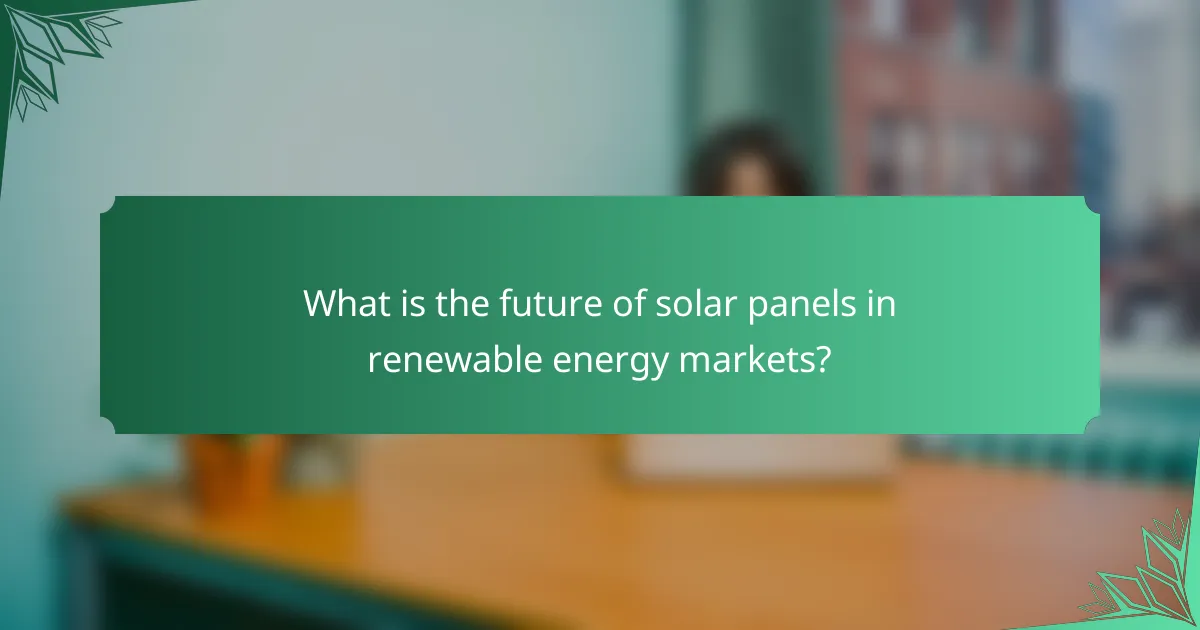
What is the future of solar panels in renewable energy markets?
The future of solar panels in renewable energy markets is promising and expected to grow significantly. Global solar energy capacity reached over 800 gigawatts in 2020 and is projected to double by 2025. This growth is driven by decreasing costs, which have fallen by 89% since 2009. Technological advancements, such as bifacial panels and solar tracking systems, enhance efficiency and energy output. Government policies and incentives are increasingly supporting solar adoption worldwide. The International Energy Agency forecasts solar to become the largest source of electricity by 2030. As demand for clean energy rises, solar panels will play a crucial role in achieving sustainability goals.
How are solar panels evolving in technology and design?
Solar panels are evolving through advancements in efficiency, materials, and design. Recent technologies have increased solar cell efficiency to over 26%. New materials, such as perovskite, are being integrated to enhance performance. These materials can be produced at lower costs than traditional silicon. Design innovations include building-integrated photovoltaics (BIPV), which seamlessly integrate solar panels into building materials. This approach improves aesthetics while generating energy. Additionally, flexible solar panels are being developed for diverse applications, including wearables and portable devices. The evolution of solar tracking systems allows panels to follow the sun, maximizing energy capture. These advancements contribute to broader adoption and improved energy output in renewable energy markets.
What advancements are being made in solar panel efficiency?
Recent advancements in solar panel efficiency include the development of bifacial solar panels. These panels can capture sunlight on both sides, increasing energy output by up to 30%. Additionally, perovskite solar cells are emerging as a game-changer. They can achieve efficiencies exceeding 25% and are cheaper to produce than traditional silicon cells. Research also shows that tandem solar cells, which combine perovskite and silicon layers, can reach efficiencies above 30%. Furthermore, innovative materials and manufacturing techniques are being explored to enhance light absorption. These advancements indicate a significant push towards more efficient solar technology, promising greater energy production and reduced costs in the future.
How do new materials impact solar panel performance?
New materials significantly enhance solar panel performance. They improve efficiency, durability, and cost-effectiveness. For instance, perovskite solar cells can achieve over 25% efficiency, surpassing traditional silicon cells. These materials also allow for lightweight and flexible designs. This flexibility can lead to new applications in various environments. Additionally, advancements in materials can reduce production costs, making solar energy more accessible. Research indicates that integrating new materials can lead to higher energy yield under diverse conditions. Therefore, the evolution of materials directly correlates with improved solar panel performance and wider adoption in renewable energy markets.
What role do solar panels play in global energy transition?
Solar panels are crucial in the global energy transition. They convert sunlight into electricity, reducing reliance on fossil fuels. This shift is essential for lowering greenhouse gas emissions. In 2022, solar energy accounted for about 10% of global electricity generation. Solar panels also promote energy independence for countries. They provide a sustainable and renewable energy source. The decreasing cost of solar technology encourages widespread adoption. As efficiency improves, solar panels become more accessible to consumers.
How do solar panels contribute to reducing carbon emissions?
Solar panels contribute to reducing carbon emissions by generating electricity without burning fossil fuels. They convert sunlight into energy, which decreases reliance on coal and natural gas power plants. According to the U.S. Department of Energy, solar energy can reduce greenhouse gas emissions by over 90% compared to traditional energy sources. In 2020, solar power prevented approximately 100 million metric tons of carbon dioxide emissions in the United States alone. This transition to solar energy supports global efforts to mitigate climate change. By utilizing solar panels, households and businesses can significantly lower their carbon footprints.
What are the economic benefits of adopting solar energy?
Adopting solar energy provides significant economic benefits. It reduces electricity costs for consumers and businesses. Solar energy systems can lower utility bills substantially. According to the Solar Energy Industries Association, residential solar can save homeowners an average of $20,000 over 20 years.
Additionally, solar energy creates jobs in manufacturing, installation, and maintenance. The National Solar Jobs Census reported over 250,000 solar jobs in the U.S. in 2019. Solar energy also stimulates local economies by increasing demand for local services and products.
Moreover, solar energy reduces dependence on fossil fuels. This shift can lead to lower energy prices due to decreased demand for traditional energy sources. Furthermore, solar installations can increase property values. A study by the Lawrence Berkeley National Laboratory found that homes with solar panels sold for 4.1% more on average.
Overall, the economic advantages of solar energy adoption include cost savings, job creation, and increased property values.
What challenges do solar panels face in the renewable energy market?
Solar panels face several challenges in the renewable energy market. High initial costs hinder widespread adoption. Installation and maintenance require skilled labor, which can be scarce in some regions. Additionally, solar energy production is intermittent, relying on sunlight availability. This intermittency necessitates energy storage solutions, which can be expensive. Market competition from other energy sources, like natural gas, also poses a challenge. Regulatory policies and incentives vary significantly across regions, affecting investment attractiveness. Finally, space requirements for large solar farms can limit deployment in densely populated areas.
What regulatory hurdles affect solar panel deployment?
Regulatory hurdles affecting solar panel deployment include zoning restrictions, permitting processes, and interconnection standards. Zoning laws may limit where solar installations can be placed. Permitting processes often involve lengthy approvals that delay projects. Interconnection standards dictate how solar systems connect to the grid, which can complicate installations. Additionally, inconsistent regulations across states create confusion for developers. These factors collectively slow down the adoption of solar technology. According to a report by the National Renewable Energy Laboratory, regulatory barriers can increase project costs by up to 30%.
How does public perception influence solar panel adoption?
Public perception significantly influences solar panel adoption. Positive public perception can lead to increased demand for solar technology. When individuals view solar panels as beneficial, they are more likely to invest in them. Studies show that communities with high awareness of climate change tend to adopt solar energy at higher rates. For example, a survey by the Solar Energy Industries Association found that 90% of respondents support solar energy. This support translates into policy changes that facilitate solar adoption. Conversely, negative perceptions, such as concerns about cost or efficiency, can hinder adoption rates. Addressing these perceptions through education and outreach can enhance solar panel uptake.

What are the market trends for solar panels?
The market trends for solar panels indicate significant growth and innovation. Global solar panel installations reached 162.5 gigawatts in 2020, showing a 20% increase from the previous year. The International Energy Agency projects that solar power could become the largest source of electricity by 2025. Cost reductions are a key trend; solar panel prices fell by 90% from 2010 to 2020. Technological advancements, such as bifacial solar panels, are enhancing efficiency. Additionally, government incentives and policies are driving market expansion. Countries like China and the U.S. lead in solar capacity installations. The market is also seeing increased interest in energy storage solutions alongside solar technology.
How is the demand for solar panels changing globally?
The demand for solar panels is increasing globally. This growth is driven by rising energy needs and climate change awareness. Countries are investing heavily in renewable energy sources. For instance, the International Energy Agency reported that solar capacity grew by 22% in 2020. Additionally, technological advancements are reducing costs. The price of solar panels has dropped by over 80% since 2010. Government incentives are also boosting installations worldwide. In 2021, the global solar market reached a record 167 gigawatts of new capacity. This trend indicates a strong shift towards sustainable energy solutions.
What regions are leading in solar panel installation?
China, the United States, and Germany are leading in solar panel installation. China dominates the global market, accounting for over 30% of total solar capacity as of 2022. The U.S. follows with significant installations, particularly in California and Texas. Germany remains a key player in Europe, known for its early adoption and strong policies supporting solar energy. These regions have invested heavily in renewable energy infrastructure. They are driving advancements in solar technology and efficiency.
How do government incentives affect solar panel sales?
Government incentives significantly boost solar panel sales. These incentives include tax credits, rebates, and grants. They lower the overall cost of solar installations for consumers. For instance, the Federal Investment Tax Credit (ITC) offers a 26% tax credit for solar systems installed in 2020-2022. This financial support makes solar energy more accessible. Research shows that states with stronger incentives see higher adoption rates. A study by the National Renewable Energy Laboratory found that incentives can increase installations by up to 50%. Therefore, government incentives play a crucial role in driving solar panel sales.
What innovations are shaping the future of solar panels?
Innovations shaping the future of solar panels include bifacial technology, perovskite materials, and enhanced energy storage solutions. Bifacial solar panels capture sunlight from both sides, increasing energy output by up to 30%. Perovskite solar cells offer higher efficiency rates and lower production costs compared to traditional silicon cells. Energy storage advancements, such as lithium-silicon batteries, improve the reliability of solar energy by storing excess energy for use during non-sunny periods. Additionally, smart solar technology integrates artificial intelligence to optimize energy production and consumption. These innovations collectively enhance the performance, efficiency, and affordability of solar energy systems.
How are energy storage solutions integrated with solar panels?
Energy storage solutions are integrated with solar panels through battery systems. These batteries store excess energy generated by solar panels during the day. This stored energy can be used at night or during periods of low sunlight. The integration allows for a more reliable power supply. It also enhances energy efficiency by reducing waste. Many systems use lithium-ion batteries due to their high energy density. According to the U.S. Department of Energy, energy storage can increase solar energy utilization by up to 30%. This integration supports grid stability and reduces reliance on fossil fuels.
What role does smart technology play in solar energy systems?
Smart technology enhances solar energy systems by optimizing energy production and consumption. It enables real-time monitoring of solar panel performance. This technology can adjust energy usage based on demand and supply fluctuations. Smart inverters convert solar energy into usable electricity efficiently. They also provide data analytics for performance improvement. Additionally, smart technology facilitates integration with energy storage systems. This integration allows for better management of generated energy. Studies show that smart technology can increase solar energy efficiency by up to 30%.
What are the implications of solar panel advancements for consumers?
Solar panel advancements significantly reduce energy costs for consumers. Improved efficiency means consumers can generate more electricity from the same amount of sunlight. For instance, recent solar panels can achieve efficiencies over 22%, compared to older models around 15%. This increase translates to lower electricity bills and faster return on investment. Additionally, advancements in battery storage allow consumers to store excess energy for use during peak hours. Enhanced durability and longer warranties also mean consumers can expect a more reliable product. As technology progresses, government incentives and rebates may further decrease initial costs. Overall, these advancements empower consumers to adopt cleaner energy solutions more feasibly.
How can consumers maximize the benefits of solar panels?
Consumers can maximize the benefits of solar panels by optimizing their installation and usage. Properly positioning solar panels to receive maximum sunlight increases energy production. Regular maintenance, such as cleaning panels and checking for obstructions, ensures efficiency. Consumers should also consider battery storage systems to utilize solar energy during non-sunny periods. Utilizing net metering allows consumers to sell excess energy back to the grid, enhancing financial returns. Additionally, taking advantage of government incentives and rebates can significantly reduce initial costs. Studies show that well-optimized solar systems can increase energy savings by up to 30%.
What are the best practices for maintaining solar panel systems?
Regular cleaning of solar panels enhances efficiency. Dust, dirt, and debris can block sunlight. It is recommended to clean panels at least twice a year. Use soft brushes or cloths and avoid harsh chemicals. Inspect the panels for damage periodically. Look for cracks, loose connections, or corrosion. Monitoring system performance is crucial. Track energy output to identify issues early. Scheduling professional inspections annually ensures thorough maintenance. These practices can extend the lifespan of solar panel systems significantly.

What is the future outlook for solar panels in renewable energy markets?
The future outlook for solar panels in renewable energy markets is highly optimistic. Global solar capacity is projected to reach 4,000 gigawatts by 2025. This growth is driven by decreasing costs and improved technology. In 2020, the cost of solar energy fell by 89% since 2009. Governments worldwide are increasing investments in solar infrastructure. The International Energy Agency anticipates solar to be the largest source of electricity by 2030. Additionally, innovations in energy storage are enhancing solar panel efficiency. These factors collectively indicate a robust future for solar panels in the renewable energy sector.
How will solar panels impact energy pricing in the future?
Solar panels will likely reduce energy pricing in the future. Increased adoption of solar technology leads to greater energy supply. This surplus can drive down prices due to competition in the energy market. Additionally, solar panels reduce reliance on fossil fuels, which are subject to price volatility. According to the International Renewable Energy Agency, solar energy costs have fallen by 89% since 2009. This trend indicates that as technology improves, costs will continue to decrease. Furthermore, government incentives for solar energy adoption will encourage more installations. Increased efficiency and lower production costs will also contribute to cheaper energy pricing.
What trends indicate a shift in energy market dynamics?
Increasing adoption of renewable energy sources indicates a shift in energy market dynamics. The global investment in renewable energy reached $500 billion in 2021, reflecting a growing commitment to sustainable solutions. Solar energy capacity has surged, with installations exceeding 150 GW in 2020 alone. Government policies are increasingly favoring clean energy, with over 140 countries implementing renewable energy targets. Technological advancements in solar efficiency are driving down costs, making solar power more accessible. The rise of energy storage solutions is enhancing the reliability of renewable sources. Consumer preferences are shifting towards sustainable energy options, influencing market demand. These trends collectively signify a transformative change in the energy landscape.
How might solar panels influence energy independence for countries?
Solar panels can significantly enhance energy independence for countries. They reduce reliance on imported fossil fuels. Countries can generate electricity from abundant sunlight. This local energy production decreases vulnerability to global energy market fluctuations. According to the International Energy Agency, solar energy capacity grew by 22% in 2020. Increased solar adoption leads to job creation in renewable energy sectors. Countries investing in solar technology can achieve self-sufficiency in energy. This transition supports national security and economic stability.
What steps can individuals take to support solar energy growth?
Individuals can support solar energy growth by adopting solar technology and advocating for policies that promote renewable energy. Installing solar panels on homes reduces reliance on fossil fuels. This action contributes to lower greenhouse gas emissions. Supporting local solar initiatives can also boost community investments in solar projects. Educating others about the benefits of solar energy raises awareness. Participating in community solar programs allows individuals to invest in solar without installing panels. Additionally, contacting local representatives to support solar-friendly legislation can drive policy changes. According to the Solar Energy Industries Association, solar energy capacity in the U.S. grew by 167% from 2016 to 2020, demonstrating the impact of individual and collective efforts.
How can communities promote solar panel installations?
Communities can promote solar panel installations through education and awareness campaigns. These initiatives inform residents about the benefits of solar energy. They can include workshops, seminars, and informational materials. Financial incentives also play a crucial role. Communities can partner with local governments to offer tax credits or rebates. Establishing bulk purchasing programs can lower costs for residents. Collaborating with local businesses can increase visibility and support. Additionally, communities can create solar co-ops to facilitate collective purchasing. Research shows that informed communities show higher adoption rates of solar technology. A study by the National Renewable Energy Laboratory found that community engagement significantly boosts solar adoption.
What resources are available for individuals interested in solar energy?
Individuals interested in solar energy can access various resources. Government websites provide information on incentives and rebates. Non-profit organizations offer educational materials and workshops. Online platforms host forums for community discussions and advice. Academic institutions publish research papers on solar technology advancements. Solar companies provide product catalogs and installation guides. Local utility companies may offer programs for solar energy users. Trade associations share industry news and best practices. These resources collectively support individuals in understanding and utilizing solar energy effectively.
The main entity of this article is solar panels, which are pivotal in the renewable energy markets. The article outlines the promising future of solar panels, highlighting projected growth in global solar capacity, advancements in technology and efficiency, and the significant role of government incentives. It discusses how innovations such as bifacial and perovskite solar cells enhance performance and affordability while addressing challenges like high initial costs and regulatory hurdles. Additionally, the article examines the economic benefits of solar energy adoption, its impact on carbon emissions, and the importance of public perception in driving demand. Overall, the content provides a comprehensive analysis of market trends, technological advancements, and the implications for consumers and communities.